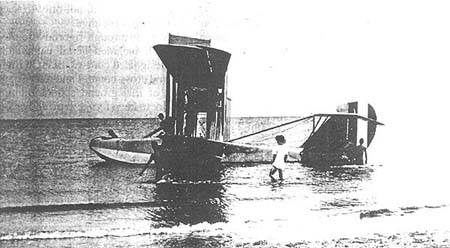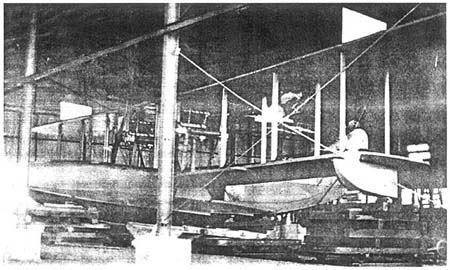PHILIPPINE
AIR SERVICE
1920 - 1921

A
Philippine Air Service Seagull just offshore of the beach runway
at
Camp Claudio. Note that this aircraft has an "A" series tail number
denoting
that
at one time this aircraft was part of the U.S. Navy's inventory.
Stevenot
and Croft approached the Curtiss Company with their business proposition
and negotiated a franchise as the company's Far Eastern representatives.
Along with another investor, Lt. Carrol Stein, they organized the local
arms of the Curtiss Aeroplane & Motor Corporation, and the Curtiss
School of Aviation and bought three Jennys and two Seagulls. They established
the Curtiss School of Aviation at Camp Claudio on the outskirts of Manila.
In addition, Stevenot and Croft recruited the services of Robert Johnson
as
chief mechanic for the new aviation school. The Curtiss School of Aviation
was established near the beach where they would be able to take advantage
of the water and utilize the wide and packed sand as a runway. Camp Claudio
was the former training camp for the Philippine National Guard Infantry.
It was named after Private Tomas Mateo Claudio who joined the U.S. Army
and served as part of the American Expeditionary Force in France. In 1918
at the battle of Chateau-Thierry in France, Private Claudio was killed.
For his heroism on the battlefield, the Philippine National Guard named
its training camp in his honor.
Once
the Curtiss School of Aviation was established, Major Stevenot approached
the Governor General of the Philippines, Francis Burton Harrison, with
a proposal, "to instruct and train Filipino military officers as pilots."
The United States had long planned to grant the Philippines its independence
in 1945. Harrison knew that for the Philippines to become an independent
Republic, it needed not only to establish itself economically, but would
also need to be able to protect itself. Military aviation would therefore
be an important part of the Islands' defense and internal security. The
Governor General agreed to fund the training of 30 aviation cadets, all
of whom would be drawn from the officer ranks of the Philippine National
Guard and Constabulary. In addition to the 30 military aviation cadets,
Stevenot and Croft accepted 10 more civilians as cadets.

An
air Service Curtiss F-5L flying boat in its final stages of assembly and
rigging.
Both
Liberty engines have been mounted.
|

